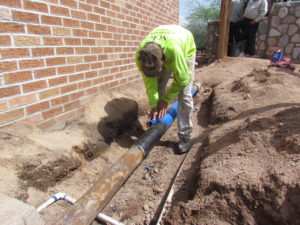†Preventing Frozen Pipes and Water Main Breaks When temperatures plummet during harsh winters, water freezing inside pipes becomes a common problem, often culminating in pipes bursting and causing severe damage. As highlighted in The Weather Channel’s article, the bursting occurs not due to the expanding ice itself, but because the ice formation obstructs the pipe’s flow entirely, leading to increased pressure. Smaller-diameter pipes are especially prone to such blockages. Given the persistent sub-zero conditions this winter, both homeowners and utility providers need to adopt precautionary measures to prevent pipe ruptures. Challenges Faced in Wisconsin and Canada In Wisconsin, the frigid weather has triggered numerous water line breaks. In February alone, Milwaukee’s water department tackled 305 main breaks, more than twice the usual number for January. When frost penetrates up to four feet underground, pipes buried at those depths can freeze rapidly. To address lateral pipe blockages, specialized tools like steam are employed. However, if the blockage is located near the mainline under the street, excavation might be necessary, with thawing taking anywhere from 30 minutes to 12 hours, costing hundreds to over a thousand dollars per repair. Averting these problems can be achieved by allowing water to trickle through faucets, though this might slightly hike up water bills. It’s crucial to remember that if a pipe bursts inside your home, the homeowner—not the city—is responsible for the repairs. Canada is experiencing a similarly severe cold snap, resulting in a sharp rise in water main breaks. On a single day, Regina’s municipal workers identified 33 water main breaks, while Saskatoon reported seven. Typically, Regina sees about 41 pipe bursts in February, but this year, the count reached 49 by the 25th. Unprecedentedly low temperatures, dropping below -55°F, are driving this spike. These frost conditions affect not just older pipelines but newer installations as well, leaving no infrastructure immune to bursts. Even the Royal University Hospital wasn’t spared, suffering damages nearing $10,000 due to a pipe burst, which included repair costs and cleanup efforts. Fortunately, no procedures were canceled, but the outpatient area had to be relocated, and infection prevention teams are assessing potential risks of contamination spread. Proactive Solutions with Carbon Fiber HJ3 Composite Technologies presents a forward-thinking solution to prevent pipe bursts using their CarbonSeal carbon fiber reinforcement system. This system complies with ANSI/NSF-61 standards for potable water and safeguards against burst-inducing ice blockages. While installing CarbonSeal initially requires an investment, it usually costs 50-80% less than repairing or replacing burst pipes afterward. Additionally, it helps circumvent costly damages caused by water pipe failures. The carbon fiber system strengthens the pipe’s hoop strength, seals leaks, and contains existing cracks. Wrapping both small and large diameter pipes with HJ3’s CarbonSeal before any incidents occur can save considerable time and resources. Secure Your Water Transmission Pipelines If you’re worried about your water transmission pipelines and wish to explore HJ3’s carbon fiber reinforcement systems further, feel free to reach out to our project managers at [insert contact details]. ††This winter has been particularly challenging for many regions, especially those prone to extreme cold. The combination of low temperatures and aging infrastructure poses significant risks to communities across North America. By investing in preventative measures like the CarbonSeal technology, we can mitigate these risks and ensure that our water systems remain reliable and functional even during the harshest conditions. For instance, the City of Mammoth recently faced a major water pipe repair after a burst caused significant flooding in a residential area. The incident highlighted the importance of having robust preventive strategies in place. While immediate repairs are critical, long-term solutions such as the CarbonSeal system offer a sustainable way to protect against future disasters. Investing in such technologies now could save millions in potential damages down the road. Moreover, cities like Regina have learned valuable lessons from past experiences. Their recent surge in water main breaks underscores the urgent need for innovation in pipe maintenance and upgrading practices. Initiatives like the CarbonSeal program represent a step forward in addressing these challenges proactively. As we continue to face unprecedented weather patterns, it’s vital that municipalities and property owners alike prioritize investments in resilient infrastructure. In conclusion, while the current situation is daunting, there are practical steps we can take to safeguard our water supplies. Whether it’s maintaining consistent water flow through faucets during freezing periods or opting for advanced reinforcements like CarbonSeal, every effort counts. Let’s work together to build stronger, more resilient communities capable of withstanding whatever Mother Nature throws our way. Pof Heat Shrink Film,Heat Shrink Film POF,Shrink Film Raw Material Cangzhou Yunfeng Packaging Products Co., Ltd. , https://www.yunfengpackaging.com
â€

